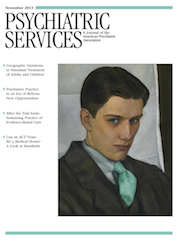Geographic Variation and Disparity in Stimulant Treatment of Adults and Children in the United States in 2008
Abstract
Objective
This study estimated the prevalence of stimulant treatment among both adults and children at national, state, and county levels during 2008 and explored explanations for wide variations in treatment prevalence.
Methods
Records of 24.1 million stimulant prescriptions dispensed to insured and uninsured patients were obtained from approximately 76% of U.S. retail pharmacies. Data were weighted to estimate treatment prevalence on March 15, 2008, for all U.S. states and counties. Regression models were used to estimate the associations among the counties’ treatment rates and the characteristics of the counties and their resident populations.
Results
An estimated 2.5% of children ≤17 years of age (3.5% of males and 1.5% of females) and .6% of persons >17 years of age were being treated with stimulants in March 2008. Treatment prevalence among states varied widely, and variation among counties was even wider. Two-thirds of the variation among counties in treatment prevalence was associated with supply of physicians, socioeconomic composition of the population, and, among children, funding for special education. Rates of children and adults in treatment were highly correlated.
Conclusions
Wide variations in treatment prevalence signal disparities between established clinical practice guidelines and actual practice, especially for primary care, where most patients prescribed stimulants are managed. Better education and training for physicians may improve identification and treatment, thereby reducing disparities in care for attention-deficit hyperactivity disorder and other disabling conditions.



